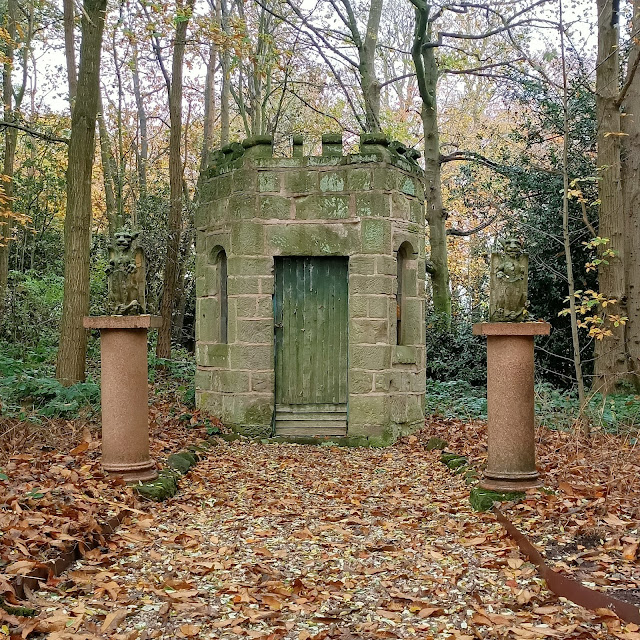A Green Spot in the Industrial History the Potteries
I like it when coincidences happen. I’m currently reading Tristram Hunt’s ‘The Radical Potter’, detailing local potter, entrepreneur and abolitionist Josiah Wedgwood's (1730-1795) incredible life. The chapter that fascinated me concerned some of the industrial disputes he fought with his workers.
 |
| Tristram Hunt's book |
It piqued my interest as I had been made aware by blog
reader Shirley Kennerley (thank you!) of a historical article the previous week
that outlined the resolution of an industrial dispute in Betley village. Part
of it mentioned Thomas Twemlow, connected to Betley Court by the fact his son,
Francis married into the Fletcher family, “and so came in to the estate of that
family”. Thomas ventured into the pottery business, and was a contemporary of
Josiah Wedgwood. The writer notes, rather witheringly,
“Thomas Twemlow is referred to in
some of the letters of Josiah Wedgwood, and this is all that can be gathered
respecting his career as a manufacturer, of his success is failure. “
The article was part 13 of a feature series called Up and
Down the County, and the Saturday 28 February 1880 instalment of
‘Staffordshire Sentinel & Commercial & General’ had as its focus,
Betley Court. These days, a feature like this would be accompanied by several
pages of glossy photographs. Back in 1880, certainly in a regional newspaper,
words were used to paint a picture instead – the article stretches to five
pages of A4 with a font size of 11pts, some 3187 words when transferred to a modern
word-processing format. Victorian readers had some stamina when it came to
newspaper articles!
 |
| 19th centruy facade of Betley Court. Note the 'triumphal arch' style porch (photo: taken from This Old House by Prof GN Brown) |
The article began with a description of Betley, its ‘big house’ Betley Court, and brief biographies of some of the main figures that dominated village life. Then it went on to describe how Francis Twemlow (1783-1865), son of Thomas Twemlow of Hill Top, Sandbach (now Hill House, a residential home for adults) came to marry the youngest of the Fletcher children, Elizabeth (1785-1863) in 1814. The following year, Francis was made county justice of the peace. He was evidently well respected as a magistrate, and “considered, even by legal professional men themselves the most able gentleman in the Commission”. Not only was he a brilliant legal mind, with tenacious spirit and accurate memory, he was regarded as a kind man, earning him, “the unfeigned admiration and respect of all classes in the country.” These qualities were to bring him to the attention of those of influence in the Potteries during a turbulent period of industrial unrest.
 |
| The Hill, Sandbach, Francis Twemlow's family home, from an old sketch found in Francis Randle Twemlow's book Twemlows, Their Wives & Their Homes From Original Records published in 1910 |
 |
| The Mansion Hill Top as it is now known, photo: Google Street |
 |
| Francis Twemlow. Photo credit as above |
The 1830s had seen a series of damaging strikes hitting the potbanks of North Staffordshire. After the longest strike had rolled on for months, it was decided something had to be done. A Board of Arbitration was convened, as not only was this a local matter affecting the Potteries, ‘operatives’ (members of the workforce) from other industries from all over the UK were taking a keen interest. Francis Twemlow was persuaded to preside over the Board, with George Tollet (of Betley Hall) to help him umpire. It was really important that the arbitration process not be seen as the representatives of the law siding with wealthy industrialist against the operatives, so the fact Francis was respected by all classes of men was to stand him in good stead.
The arbitration was scheduled for 30th December 1836.
Delegates travelled in from Bristol, Sheffield, Birmingham, Worcester, Glasgow,
Manchester, Huddersfield, in fact, from almost all over the UK. The Chamber of
Commerce was hastily assembled, hoping to influence proceedings, but Francis would have
none of it and quickly disposed of them. The writer continues,
“Picture Betley when they arrived
at the little village. Imagine these men from all parts of the kingdom filing
under the lime trees that shut in Betley Court. How little of the beauty of the
scene would appear to them —the lanes and homesteads, the solemn church, and the
brick-built Court with its red front, the tower and the clean, bright dial the
clock tower, the quaint cottages, with their homely thatch, would possess
little to attract these feverish contentions men. Where man's interest is,
there the man's whole thought is concentrated, and he has not a passion or a
feeling beyond[1]?”
It must have been quite a sight, all the delegates arriving
in Betley village. The room they were to use was in the house of a Mr Harding,
a solicitor, and it was located next door to the Swan Inn. Ordinarily, this was
where the magistrates held their petty courts. The Board of Arbitration was
made up of 22 men; eight manufacturers, eight union workmen and six non-union
workmen. First, six of the workmen were called up to give their grievances.
Their mains issue was a practice called ‘annual hiring’ where a potter was tied
to one potbank for a year, but could end up with no work and no pay, and unable
to leave for another employer. They also objected to a practice called ‘working
good out of the oven’. This meant that the employer only paid for work
considered of acceptable quality coming out of the bottle kiln. In practice,
employers were often still glazing and selling wares that they had refused to
pay for when the kiln was open. Workers wages were drastically cut as a result
and they had no means of redress.
On the opposing side, the employers defended annual hiring, arguing
that they needed protection from employees simply upping sticks and leaving
them in the lurch. They argued too, that bringing in a system of ‘working good
from hand’ (pre-fired state) rather than ‘out of the oven’ would not lessen the
problems the potters experienced.
Francis had an almost impossible feat to keep both sides
happy and forge some resolution, but try he did. Having listened to both sides,
on the matter of ‘annual hiring’ he suggested that any workman engaged this way
should be secured “sixteen clear days’ of work each month, or failing this, the
workman should be allowed his plea of breach of contract.” On the matter of ‘good
from oven’ which had caused so much anger, he found that ‘for all ware that
found its way to the dipping tub [glazing stage] the men should receive pay’. The workers had
their protection and redress, and the employers had their “clause securing them
against the ruinous and destructive turnouts”.
The judgement ended a twenty-six-week strike, in a peaceful
manner, and a mark of its soundness is that for decades to come, it was
referred back to when industrial relations faltered. The writer’s last words on
the subject conclude,
“…for years after, the decision
of Betley was appealed to, and the little village remembered a green spot in
the industrial history the Potteries.”
 |
| Visitors on a recent Restoration Tour, up on roof level on Betley Court |
Apologies for the long post – I’m evidently being influenced
by my Victorian predecessor! Next week, I’ll have an update on the next stage
of the rebuild – Phase 1B: the new roof! Tickets are still available on
Eventbrite for the next restoration tour December 11-12th. £10 per
person, over 8s only. Complimentary mince pie (we promise, not baked by Nigel) and
mulled wine for all. Hoorah!
All best wishes
Ladybird Su
[1]
All quotes from Up and Down the Country XVIII, Staffordshire Sentinel
and Commercial & General Advertiser, Saturday 28 February, 1880. Retrieved
from the British Newspaper Archive, Nov 2021.




Comments
Post a Comment